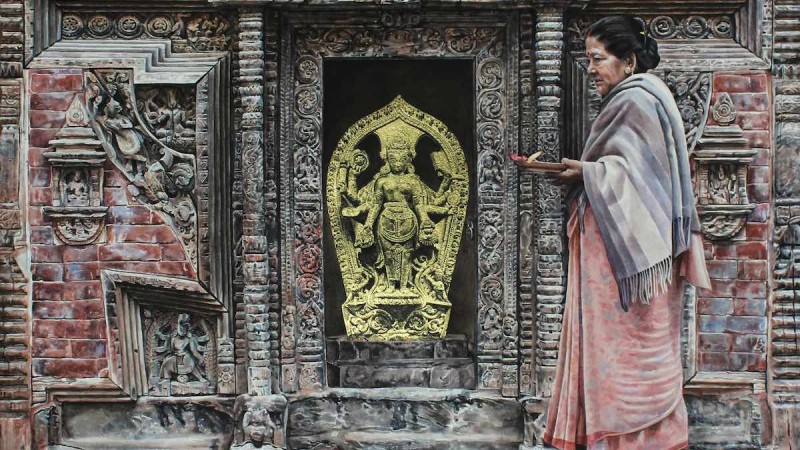 [1]
[1]Lakshmi-Narayana – 15th-century stone, 34 inches. Stolen in 1984 from Narayan Temple, Patko Tol, Patan. Image by Joy Lynn Davis. Used with permission
Kathmandu, the capital city of Nepal, is an open museum of art and culture. With countless temples, including seven UNESCO World Heritage Sites [2], the Kathmandu Valley [3] is not only an attraction for art lovers and religious pilgrims, but also for art thieves and smugglers.
Many statues, hundreds of years old, were stolen from the temples after the 1950s [4], not just by professional smugglers, but also high-profile expatriates [5] and powerful elites [6]. A huge cache of wild animal parts and centuries-old idols discovered by Nepal police during a raid [7] in 2009 at adventurer Ian Baker [8]’s residence in Kathmandu hints at the magnitude of theft and involvement of big names.
Efforts have been made over the years to document the looting, including “Lost Images of Nepal [9]” by Lain Singh Bangdel, “Gods are leaving the country: Art theft from Nepal [10]” by Jurgen Schick and “Gods in Exile [11]” by Kanak Mani Dixit. Inspired by [12] these publications, American artist Joy Lynn Davis [13] visited the theft sites and recorded the memories shared by locals. Building on the work done by Bangdel and Schick, she started painting the sacred places from where the statues were stolen and visually ‘repatriating’, in her words, the stolen sculptures with 23 karat gold.
According to Davis, the gold symbolises commodification of the priceless sculptures and makes them visually stand out in her photorealistic paintings – making people aware of their absence.
Joy Lynn Davis is artist & researcher, part of gathering movement for documentation & return of stolen Nepal statuary pic.twitter.com/Jcje8aX4H4 [14]
— Kanak Mani Dixit (@KanakManiDixit) April 8, 2015 [15]
“Remembering the Lost Sculptures of the Kathmandu Valley”, an art exhibition currently running at Nepal Art Council in Kathmandu, showcases her valuable work.
Recalling what's lost
The movement to restore the stolen artwork is relatively young. During the 1980s, Nepali artist and scholar Lain Singh Bangdel and German art connoisseur Jurgen Schick took on the arduous task of documenting the lost statues [6]. The Huntington Archive [16] at Ohio State University showcases the images photographed by Lain Singh Bangdel in his book “Stolen Images of Nepal”.
After seeing the before and after images of theft idols published in his book, a Californian art collector returned four sculptures [17] in August 1999 and another statue was returned from Berlin, reports Nepali Times.
Donna Yates, an archaeologist studying antiquities smuggling, archaeology and art crime, tweeted a photo from the archive:
Before and after. Sculpture mutilated during a looting attempt. Lost & Stolen Images: Nepal http://t.co/sNQmhrpStz [18] pic.twitter.com/ySH1v13MnX [19]
— Donna Yates (@DrDonnaYates) October 10, 2014 [20]
At Davis’ exhibition in Kathmandu, informational panels display historical photographs of the stolen sculptures, current photographs of the sites and information about the stolen sculptures including maps depicting the original theft sites. Earlier, she showcased her works at the exhibition ‘Narratives of Faith and Memory: Remembering the Lost Sculptures of Kathmandu [12]’ in 2013 at the Patan Museum in Lalitpur, Nepal.
Part of Davis’ efforts includes an interactive map and database [21] of stolen artwork. According to the project's website, its contents will be added to the International Criminal Police Organisation's (Interpol)'s own database of stolen art.
Database of lost & stolen #NepaleseArt [22] to be linked to Interpol. Kudos to Joy Lynn Davis for her hard work! http://t.co/xUGfTpDtmR [23]
— AMaki (@MakiAriana) April 13, 2015 [24]
Where #Nepal [25]’s idols were stolen from and where they are now. Joy Lynn Davis Exhibit till 22 May @ Nepal Art Council pic.twitter.com/sE8IDlQH7S [26]
— Kunda Dixit (@kundadixit) April 12, 2015 [27]
Davis explains the project further in a YouTube video:
Thanks to the awareness and joint collaboration of government and non-government organisations with local communities, art stolen from Nepal [28] has been documented, and many works have been restored. Most importantly, major campaigns have been launched [29] to preserve the historic temples, monasteries, palaces, and other objects of cultural importance.
The exhibition “Remembering the Lost Sculptures of the Kathmandu Valley” runs until 22 May 2015. [30]